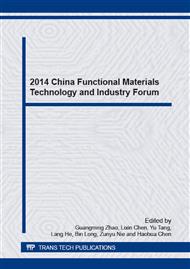[1]
S. Wen and D.D. L Chung: Cement and Concrete Research, Vol. 34 (2004) No. 2, p.329.
Google Scholar
[2]
X. Fu and D.D.L. Chung: Cement and Concrete Research, Vol. 26 (1997) No. 10, p.1467.
Google Scholar
[3]
H. Guan, S. Liu and Y. Duan: Cement and Concrete Composites, Vol. 28 (2006), p.468.
Google Scholar
[4]
B. Lu, X.L. Dong and H. Huang: Journal of Magnetism and Magnetic Materials, Vol. 320 (2008) No. 6, p.1106.
Google Scholar
[5]
X.G. Liu, D.Y. Geng and H. Meng: Applied Physics Letters, Vol. 92 (2008), p.173117.
Google Scholar
[6]
B.W. Li, Y. Shen and Z.X. Yue: Applied Physics Letters, Vol. 89 (2006), p.132504.
Google Scholar
[7]
S. Yoshida, M. Sato and E. Sugawara: Journal of Applied Physics, Vol. 85 (1999), p.4636.
Google Scholar
[8]
J.L. Xie, M. Han and L. Chen: Journal of Magnetism and Magnetic Materials, Vol. 314 (2007), p.37.
Google Scholar
[9]
A. Ohlan, K. Singh and A. Chandra: ACS Applied Materials and Interfaces, Vol. 2 (2010) No. 3, p.927.
Google Scholar
[10]
X.F. Zhang, X.L. Dong and H. Huang: Journal of Physics D-Applied Physics, Vol. 40 (2007) No. 17, p.5383.
Google Scholar
[11]
J. Chen, D. Zhao and X. Jin: Composites Science and Technology, Vol. 97 (2014), p.41.
Google Scholar
[12]
S. Kim, S. Zhou and Y. Hu: Nature Materials, Vol. 11 (2012) No. 6, p.544.
Google Scholar
[13]
Z. Yang, M. Liu and C. Zhang: Angewandte Chemie-International Edition, Vol. 52 (2013) No. 14, p.3996.
Google Scholar
[14]
Z. Yang, H. Sun and T. Chen: Angewandte Chemie-International Edition, Vol. 52 (2013) No. 29, p.7545.
Google Scholar
[15]
S. Park and R.S. Ruoff: Nature Nanotechnology, Vol. 4 (2009), p.217.
Google Scholar
[16]
M.J. Allen, V.C. Tung and R.B. Kaner: Chemical Reviews, Vol. 110 (2010), p.132.
Google Scholar
[17]
S. Stankovich, D.A. Dikin and R.S. Ruoff: Carbon, Vol. 45 (2007) No. 7, p.1558.
Google Scholar
[18]
Jr.W.S. Hummers and R.E. Offeman: Journal of the American Chemical Society, Vol. 80 (1958), p.1339.
Google Scholar
[19]
S.H. Lv, Y.J. Ma and C.C. Qiu: Construction and Building Materials, Vol. 49 (2013), p.121.
Google Scholar
[20]
S.H. Lv, J.J. Liu and T. Sun: Construction and Building Materials, Vol. 64 (2014), p.231.
Google Scholar



